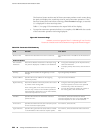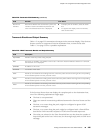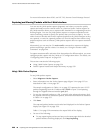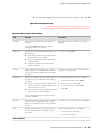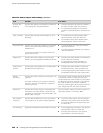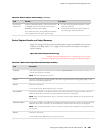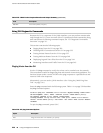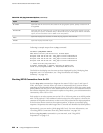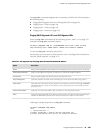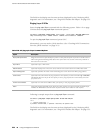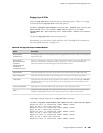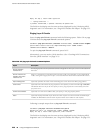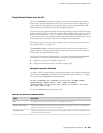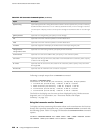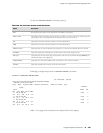
Table 116: CLI ping Command Options (continued)
DescriptionOption
(Optional) Sets the time-to-live (TTL) value for the ping request packet. Specify a value from 0
through 255.
ttl number
(Optional) Sets the maximum time to wait after sending the last ping request packet. If you do
not specify this option, the default delay is 10 seconds. If you use this option without the count
option, the Services Router uses a default count of 5 packets.
wait seconds
(Optional) Displays the interface on which the ping response was received.
detail
(Optional) Displays detailed output.
verbose
Following is sample output from a ping command:
user@host> ping host3 count 4
PING host3.site.net (176.26.232.111): 56 data bytes
64 bytes from 176.26.232.111: icmp_seq=0 ttl=122 time=0.661 ms
64 bytes from 176.26.232.111: icmp_seq=1 ttl=122 time=0.619 ms
64 bytes from 176.26.232.111: icmp_seq=2 ttl=122 time=0.621 ms
64 bytes from 176.26.232.111: icmp_seq=3 ttl=122 time=0.634 ms
--- host3.site.net ping statistics ---
4 packets transmitted, 4 packets received, 0% packet loss
round-trip min/avg/max/stddev = 0.619/0.634/0.661/0.017 ms
The fields in the display are the same as those displayed by the J-Web ping host
diagnostic tool. For information, see “Ping Host Results and Output
Summary” on page 218.
Checking MPLS Connections from the CLI
Use the ping mpls commands to diagnose the state of LSPs, Layer 2 and Layer 3
VPNs, and Layer 2 circuits. When you issue a command from a Services Router
operating as the inbound node at the entry point of an LSP or VPN, the router sends
probe packets into the LSP or VPN. Based on how the LSP or VPN outbound node at
the remote endpoint of the connection replies to the probes, you can determine the
connectivity of the LSP or VPN.
Each probe is an echo request sent to the LSP or VPN exit point as an MPLS packet
with a UDP payload. If the outbound node receives the echo request, it checks the
contents of the probe and returns a value in the UDP payload of the response packet.
If the Services Router receives the response packet, it reports a successful ping
response. Responses that take longer than 2 seconds are identified as failed probes.
Alternatively, you can use the J-Web ping MPLS tool. For more information, see
“Checking MPLS Connections from the J-Web Interface” on page 219.
Before using ping mpls commands in your network, read “Ping MPLS
Preparation” on page 215.
232 ■ Using CLI Diagnostic Commands
J-series™ Services Router Administration Guide



